The Scottish Health Survey 2011: Volume 1 - Adults
Annual report of the Scottish Health Survey for 2011. Volume focussing on adult health
CHAPTER 6 PHYSICAL ACTIVITY
Tessa Hill
SUMMARY
- In 2011, 39% of adults aged 16 and over met the physical activity recommendations with men more likely than women to meet them (45% compared with 33%). Between 2008 and 2011, there was no significant change in the proportion meeting the recommendations.
- The proportions of men and women meeting the recommended activity levels varied significantly with age in 2011. Among men, the proportion meeting the recommendations fell from 63% of those aged 16-24 to 11% of those aged 75 and over. Among women, those aged 25-34 were most likely to meet the recommendation (45%), the proportion meeting it then declined by age to 6% for those aged 75 and over.
- 84% of men and 79% of women participated in at least 10 minutes of physical activity during the 4 weeks prior to being interviewed. Men were active on a mean of 16.2 days over that period compared with 13.2 days for women.
- In 2011, sports and exercise was the most popular type of physical activity for men (54%) and second most common for women (45%) after heavy housework (61%).
- 41% of men and 31% of women reported having walked at a brisk pace for at least 10 minutes in the 4 weeks prior to interview.
- Activity levels were related to household income, with those in higher income households more likely than those with less income to meet the recommended activity levels. For example, 38% of women in the highest income quintile met the recommendations compared with 27% in the lowest income quintile.
- Deprivation was strongly related to activity levels with adults living in the two most deprived SIMD quintiles least likely to meet the recommendations (34%-35%) compared with 42% in the highest two deprivation quintiles).
6.1 INTRODUCTION
The health benefits of a physically active lifestyle are well documented and there is abundant evidence that regular activity is related to a reduced incidence of chronic conditions of particular concern in Scotland, such as cardiovascular disease, obesity, and type 2 diabetes.1 Physical activity is also associated with better health and cognitive function among older people, and can reduce the risk of falls in those with mobility problems.2 In 2008, the World Health Organisation (WHO) estimated that 3.2 million deaths per year could be attributed to low physical activity levels.3
The introductions to the physical activity chapters in the three most recent Scottish Health Survey (SHeS) reports provided a comprehensive overview of the recent policy context.4,5,6 They outlined a number of actions being taken by the Government and NHS Scotland to promote physical activity as part of a healthy lifestyle, and initiatives designed to help adults increase their activity levels. These included:
- The 2003 Physical Activity Taskforce publication Let's Make Scotland More Active: A strategy for physical activity,7 and its five year review, conducted in 2008.8
- The Scottish Government's 2008 action plan Healthy Eating, Active Living: An action plan to improve diet, increase physical activity and tackle obesity (2008-2011).9
- The Scottish Government's Route Map for tackling obesity and associated Obesity Route Map Action Plan, published in 2011.10 The Scottish Health Survey's measures of the proportion of adults who meet the physical activity recommendations, and the time spent in front of a screen, are being used to monitor progress towards the Plan's intermediate-term goal to increase energy expenditure.11
- The opportunities presented by the 2012 Olympics and 2014 Commonwealth Games to help accelerate progress towards making Scotland more active.
Allied to the above initiatives, the following adult physical activity target (set out in Let's Make Scotland More Active) is monitored by SHeS:
50% of adults should be meeting the current recommended levels of physical activity by the year 2022
In addition to this target, the revised National Performance Framework (NPF)12 published by the Scottish Government in December 2011 includes the following new national indicator for adults, also measured via SHeS:13
Increase physical activity
As with the 2022 target, the new indicator is measured in relation to the proportion of adults meeting the recommended level of activity - adults are recommended to accumulate at least 30 minutes of moderate activity on most days of the week (i.e. on at least five), which can be accumulated in shorter bouts of as little as 10 minutes. The 2010 report outlined the more detailed recommendations for children's physical activity published jointly in July 2011 by the UK's four Chief Medical Officers.14 The new UK guidelines for adults are tailored to specific age groups across the lifecourse:15
- Children and young people aged 5-18
- Should engage in moderate to vigorous activity for at least 60 minutes and up to several hours every day.
- Vigorous activities, including those that strengthen muscles and bones, should be carried out on at least 3 days a week.
- Extended periods of sedentary activities should be limited.
- Adults aged 19-64
- Should be active daily.
- Should engage in at least moderate activity for a minimum of 150 minutes a week (accumulated in bouts of at least 10 minutes) - for example by being active for 30 minutes on five days a week.
- Alternatively, 75 minutes of vigorous activity spread across the week will confer similar benefits to 150 minutes of moderate activity (or a combination of moderate and vigorous activity).
- Activities that strengthen muscles should be carried out on at least two days a week.
- Extended periods of sedentary activities should be limited.
- Adults aged 65 and over
- In addition to the guidance set out above for adults aged 19-64, older adults are advised that any amount of physical activity is better than none, and more activity provides greater health benefits.
- Older adults at risk of falls should incorporate activities to improve balance and coordination on at least two days a week.
To help monitor these new recommendations the SHeS team worked with the Scottish Physical Activity Research Collaboration to design new questions about adult sporting activities to assess their muscle strengthening potential and, for those aged 65 and over, their balance improving potential. In addition, more questions about sedentary activity are being asked (from 2003 a question has been asked about hours spent in front of a screen, from 2012 other sedentary activities such as reading will also be included). Next year's report will present the results of these new measurements, and will assess adherence to the 150 minutes of moderate activity per week recommendation as well as the new alternative recommendation of 75 minutes of vigorous activity per week.
This chapter updates the trends presented in the three previous reports. It uses summary measures based on all types of activities reported by participants. It also presents figures on the prevalence of participation in different types of activities, including sports and exercise (the detailed breakdown of different sporting activities presented last year will be re-visited in future reports). Summary activity levels by socio-demographic group are also presented.
6.2 METHODS
6.2.1 The adult physical activity questionnaire
The adult physical activity module, included in the survey from 1998 onwards is based on the Allied Dunbar National Fitness Survey, a major study of physical activity among the adult population in England conducted in 1990.16 The module examined:
- The time spent being active
- The intensity of the activities undertaken, and
- The frequency with which activities are performed.
Changes to the adult physical activity module
Some changes to the way that adult physical activity is measured were introduced to the survey in 2008. These are outlined in full in the 2008 SHeS chapter and are not repeated here.4 The main change was that prior to 2008 activities were recorded if they lasted for at least 15 minutes; from 2008 onwards activities of 10-14 minutes duration were also included. The 2008 chapter concluded that the impact of this change on the trend in the proportion of men and women meeting the physical activity recommendations was small overall.5 From this report onwards, all trends for adult physical activity include activities accumulated in bouts of 10 minutes or more, and the 2008 data are now the baseline for time series analysis.
6.2.2 Adult physical activity definitions
Types of activity covered
Four main types of physical activity were asked about:
- Home-based activities (housework, gardening, building work and DIY)
- Walking
- Sports and exercise, and
- Activity at work.
For the first three categories, participants were asked to report any activities lasting at least 10 minutes and to say on how many days in the past four weeks they had taken part in such activities. For walking, they were also asked on how many days they had taken more than one walk of at least 10 minutes. Where they had taken more than one walk, the total time spent walking for that day was calculated as twice the average reported walk time.
Those in full or part-time employment were also asked about activity at work. They were asked to rate how physically active they were in their job (options were: very physically active, fairly physically active, not very physically active and not at all physically active). Occupational activity was counted as 20 days in the last 4 weeks for full-time workers and 12 days for part-time workers.
Intensity level
Each of the activities mentioned were classified according to their intensity level. The four categories of 'intensity' of physical activity were:
- Vigorous
- Moderate
- Light, and
- Inactive.
The Scottish Government's physical activity target for adults focuses on engaging in at least moderate levels of physical activity for at least 30 minutes on most days of the week. Most of the discussion of adult physical activity in this chapter therefore focuses on moderate and vigorous intensity activities.
Home-based activities were classified as either 'moderate' or 'light' depending on their nature. Participants were given examples of types of housework, gardening, building work and DIY which were described as either 'heavy' or 'light'. All cases of 'heavy' home-based activity were classified as being of 'moderate' physical intensity. Light gardening, building work and DIY were all classified as 'light' physical intensity. Due to its very low intensity, light housework was not included in the calculations of physical activity in this report.17
For walking, participants were asked to assess their usual walking pace as 'slow', 'steady average', 'fairly brisk' or 'fast - at least 4mph'. Walks of 10 minutes or more at a brisk or fast pace were classified as being of 'moderate' intensity. Walks at slow or steady average pace were classified as 'light'.
The intensity levels of different sports and exercises were determined according to a combination of the nature of the activity and the participant's assessment of the amount of effort it involved. For example, all instances of playing squash or running/jogging were counted as 'vigorous' intensity. However, other activities, like swimming or cycling, were counted as 'vigorous' only if the participant reported that the effort involved was enough to make them 'out of breath or sweaty'; if not, they were classified as 'moderate' intensity. Similarly, other activities, like dancing, counted as 'moderate' if they made the participant out of breath or sweaty, but 'light' if not.18
Activities at work were classified using a combination of (a) the participant's assessment of how active they are in their job (described above), and (b) the Standard Occupational Classification (SOC) code assigned to their job type. For example, if participants' jobs were among a short list of particularly strenuous occupations (including, for example, miners and construction workers) and they described themselves as 'very physically active' at work, then their jobs were classified as involving 'vigorous' activity. Those who described their jobs as 'very physically active' but whose jobs were not among the list of strenuous occupations were classified as 'moderately active' at work, as were those who considered themselves 'fairly physically active' but whose occupations were classed as either strenuous (see above) or involving heavy or moderate work (for example, plasterers or refuse collectors).19
6.3 SUMMARY PHYSICAL ACTIVITY LEVELS
6.3.1 Trends in summary physical activity levels since 2008
Table 6.1 presents adults' summary physical activity levels by age and sex for each year between 2008 and 2011. In 2011, 39% of adults met the physical activity recommendations. This is the same as the proportion that met them in 2008 and 2010 (the 2009 figure was not significantly different, at 37%). Similarly, the proportions of men and women meeting the targets have been largely static since 2008: 45% of men and 33% of women met the targets in 2011; both figures were within the range reported in recent years (43%-45% and 32%-33% respectively).
The proportion of men and women with low activity levels (30% and 35% respectively) showed little variation from previous years.
There was no variation over time in the proportions meeting the recommendations by age group for either men or women.
Table 6.1
6.3.2 Summary adult physical activity levels, 2011, by age and sex
Around half of all adults aged 16-44 (48%-53%) met the physical activity recommendations in 2011. This reduced from the age of 35-44 onwards to a low of 8% of those aged 75 and over meeting the recommendation.
As in previous years, across all age groups men were more likely than women to meet the recommendations. The difference between the sexes was widest in the youngest age group (age 16-24) with 63% of men in this age group meeting the target compared with 41% of women. The gender gap narrowed with increasing age up until the age of 45-54 largely as a result of a decline in the proportion of men meeting the targets (from 61% among those aged 25-34 to 48% among those aged 45-54). The comparative figures for women fluctuated (38%-45%). The proportion meeting the recommendations declined at a similar rate for men and women from the age of 55-64 onwards with 11% of men and 6% of women aged 75 and over meeting the recommendation.
The proportion of adults in the low activity group ranged between 17%-20% for those aged 16-44 and then rose steadily to 74% of those aged 75 and over. As Figures 6A and 6B illustrate, the pattern by age was similar for both sexes. Figure 6A, Figure 6B, Table 6.1
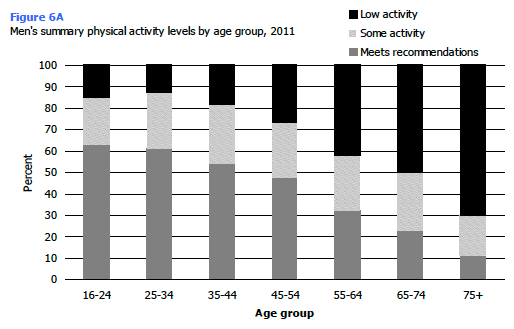
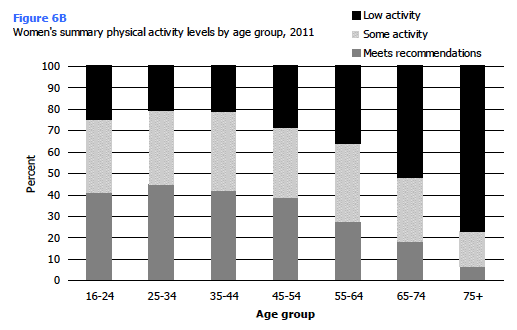
6.3.3 Participation in different types of activity in the past 4 weeks
Table 6.2 presents three different measures of participation for each of the four activity types covered in the interview (heavy housework; heavy manual work, gardening and DIY; brisk walking; sports and exercise) by age and sex. It summarises:
- the total proportion of adults participating in the activity type for at least 10 minutes at a time in the 4 weeks prior to the survey;
- the mean number of days in the previous 4 weeks on which they participated in this type of activity, and
- the mean number of hours per week they spent participating in this type of activity.
It also presents a summary measure based on those participating in any of the four types of physical activities.
These data were reported comprehensively in 20095 so the following discussion just presents an overview of the main findings. There were no major differences between the 2009 and 2011 results. Table 6.2
Any activity
In 2011, 81% of adults (84% of men and 79% of women) participated in at least 10 minutes of physical activity during the 4 weeks prior to the survey. The mean number of days of activity during that 4 week period was 14.6 (16.2 for men and 13.2 for women). Adults were active for an average of 7.2 hours per week with men spending more time being active than women (8.7 compared with 5.8 hours).
For both men and women, levels of participation for both sexes were highest among those aged 16-54 and then declined in the older age groups. There was little difference in the figures between the sexes across all age categories. The proportions participating in at least ten minutes of physical activity ranged between 87%-94% for men and 86%-91% for women aged 16-54 then declined with each successive age category thereafter. However, the drop in the levels was greatest between two the oldest age categories (65-74 and 75 and over), from 72% to 48% of men, and from 66% to 40% of women, respectively, participating in any form of activity.
The pattern by age for women's mean days of activity in the last 4 weeks was similar to that described above. The highest figures were among those aged 16-54 (14.8-16.5 days) but declined to a low of 4.0 days for those aged 75 and over. For men, there was a linear decline with age from an average of 21.2 days of activity in the last 4 weeks for those aged 16-24 to 6.7 days for those aged 75 and over.
The mean number of hours of participation per week in any activity in the 4 last weeks was highest between the ages of 16-54 for both sexes (9.5-11.7 hours for men and 6.4-7.2 hours for women). This declined with age to 2.9 hours for men and 1.3 hours for women aged 75 and over. Table 6.2
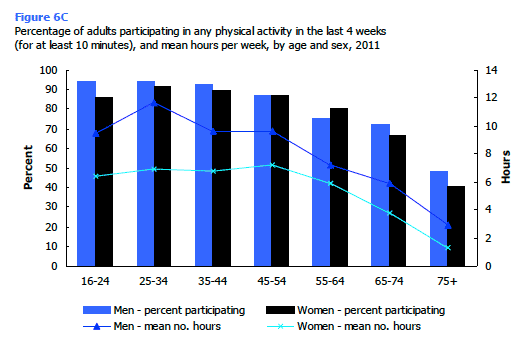
Heavy housework
As reported in previous years, heavy housework was the most common form of physical activity for women, with the exception of those aged 16-24 who were more likely to participate in sport and exercise. Overall, 61% of women had participated in heavy housework in the last 4 weeks compared with 48% of men. The mean number of days of heavy housework in the last 4 weeks was also higher for women (3.7 days) than for men (2.4 days) as was the mean hours per week (1.7 and 0.8 hours, respectively).
All participation measures showed a bell-shaped pattern when compared across the age groups. For both men and women these measures peaked between the ages of 25-54 and declined with age thereafter. For heavy housework this pattern was more pronounced for women, with a peak of 75% aged 35-44 having done heavy housework compared with a peak of 57% for men aged 25-34. However, the age-related decline was sharper for women, as in the oldest age group both sexes reported similar amounts of heavy housework (28% participated, with averages of 1.2 - 1.5 days and 0.4 hours). Table 6.2
Heavy manual work, gardening or DIY
Participation in heavy manual work, gardening or DIY was by far the least common activity for both sexes; but, as in 2009, men were three times more likely than women to have participated in this type of activity (27% versus 9%). This difference was also apparent in the other measures. On average, in the last 4 weeks men participated on 1.4 days for 1.2 hours per week. The comparative figures for women were 0.4 days and 0.3 hours.
The pattern by age varied slightly for men and women. For men, each participation measure peaked among those aged 45-54 (37% participated, averages of 1.8 days and 1.9 hours). There was a decline with age but participation levels remained higher than those reported by the youngest age group (15% of men aged 75 and over participated, with averages of 1.2 days and 0.9 hours compared with 10% of men aged 16-24 with averages of 0.3 days and 0.2 hours).
For women, the peak in participation was in the 55-64 age group (15% participated, averages of 0.8 days and 0.5 hours). The youngest and the oldest age groups reported similar participation levels (4% of both age groups participated, averages of 0.1-0.2 days and 0.1 hours). Table 6.2
Walking
Walking was the third most common activity for both sexes, though it was a minority pursuit with 41% of men and 31% of women having walked at a brisk pace for at least 10 minutes in the last 4 weeks. Men reported walking on more days in that period than women (7.6 versus 5.9 days) and spending more hours walking per week (2.5 versus 1.9 hours).
For men, all participation measures were highest among those aged 16-34 (58%-59% participated, averages of 11.0-11.6 days and 3.1-3.8 hours). These levels declined with age with the sharpest decline being seen in the oldest age group (to 11% of those aged 75 and over participating, with averages of 2.3 days and 0.5 hours).
For women, the highest figures for all measures were seen in the 16-24 age group (45% participated, average of 8.5 days and 2.7 hours). These figures dropped to a plateau between the ages of 25-44 (37%-40% participated, averages of 6.6-7.3 days and 2.1-2.2 hours) before declining again in the older age groups (8% of those aged 75 and over participated, averages of 1.4 days and 0.4 hours). Table 6.2
Sport and exercise
Sport and exercise was the most popular type of physical activity for men, and the second most popular for women, with 54% of men and 45% of women having taken part in this type of activity at least once during the last 4 weeks. Men had participated on more days in the last 4 weeks than women (7.3 versus 5.1 days), and for twice as many hours per week on average (2.4 versus 1.2 hours).
For both sexes, all measures of participation were highest in the youngest age group as 78% of men aged 16-24 participated, with averages of 11.6 days and 4.0 hours. The corresponding figures for women aged 16-24 were 65%, 7.0 days and 1.9 hours. All measures declined successively with age, with the exception of men aged 55-64 and 65-74 who had similar levels of participation on all three indicators (37-38% participated, averages of 4.3-4.5 days and 1.4-1.8 hours). Table 6.2
6.4 PHYSICAL ACTIVITY LEVELS BY SOCIO-DEMOGRAPHIC FACTORS
Tables 6.3 to 6.5 present the proportions of adults who met the physical activity recommendations of at least 30 minutes of activity on 5 or more days per week by socio-economic classification (NS-SEC of the household reference person), equivalised household income and the Scottish Index of Multiple Deprivation (descriptions of each of these measures are available in the Glossary at the end of this volume). To ensure that the comparisons presented in this section are not confounded by the different age profiles of the sub-groups, the data have been age-standardised (age-standardisation is also described in the Glossary). On the whole, the differences between observed and age-standardised percentages are small. Therefore, the percentages and means presented are the standardised ones only.
6.4.1 Adult summary activity levels, 2011 (age-standardised), by NS-SEC of household reference person and sex
The proportion of men and women meeting the recommendations varied significantly by NS-SEC but with different patterns for each sex. Men in lower supervisory and technical households were the most likely to meet the recommendations (51%) while those living in intermediate households were least likely to do so (39%).
Four in ten women living in small employer and own account worker households met the recommendations (40%). A third (36%) of those in managerial and professional households did so and the equivalent figures for the remaining household groups ranged between 30%-31%. Table 6.3
6.4.2 Adult summary activity levels, 2011 (age-standardised), by equivalised household income and sex
As reported in 2008, there was a clear relationship between income and activity levels.4
As Figure 6D illustrates, around half of men in the three highest income quintiles met the recommendations (49%-50%), in contrast, 35%-44% of men in the lowest two income quintiles did so.
The pattern for women was different with a steady decline in the proportion meeting the recommendations from the highest to the lowest income quintiles (from 38% to 27%) (Figure 6E).
It is also clear from Figures 6D and 6E that the decline in the proportions meeting the recommendations by income coincided with a large increases in low activity levels (the proportions in the 'some activity' group did not increase as sharply). Figure 6D, Figure 6E, Table 6.4
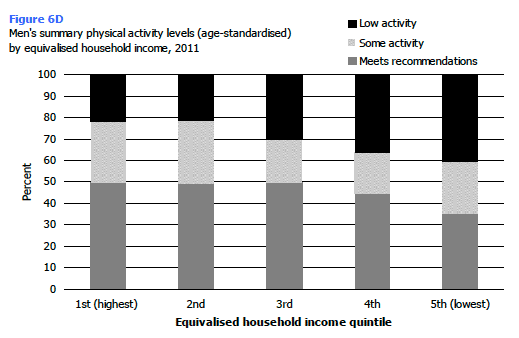
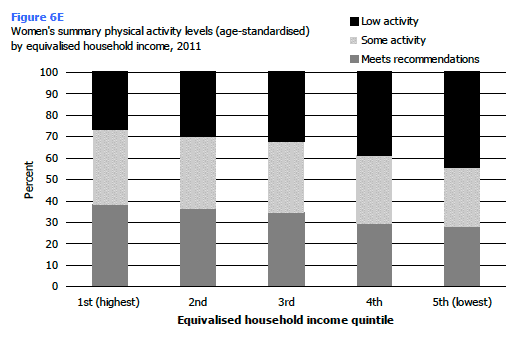
6.4.3 Adult summary activity levels, 2011 (age-standardised), by Scottish Index of Multiple Deprivation and sex
Two measures of SIMD are being used throughout this report. The first, which uses quintiles, enables comparisons to be drawn between the most and least deprived 20% of areas and the intermediate quintiles. The second contrasts the most deprived 15% of areas with the rest of Scotland (described in the tables as the "85% least deprived areas").
As in 2008, there was a significant association between area deprivation and activity levels, although the pattern was clearer in 2011.4 For both men and women, those living in the two most deprived SIMD quintiles were the least likely to meet the recommendations (39%-42% of men and 29% of women). This was significantly lower than the proportions in the other three quintiles meeting the recommendations (47%-49% of men and 35%-36% of women). As was seen with income, the proportions in the 'some activity' category did not vary as much as the 'low activity' group which saw a 12-13 percentage point increase between those in the least and most deprived quintiles (from 25% to 38% in men, and from 30% to 42% in women).
Those in the 15% most deprived areas of Scotland were significantly less likely than those in the rest of the country to meet the recommendations (33% compared with 40%). Table 6.5
Contact
Email: Julie Ramsay
There is a problem
Thanks for your feedback